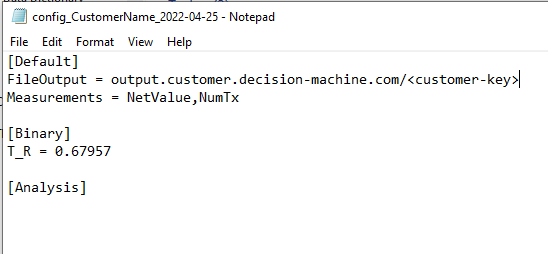Information about how to use OnDemand and the Data Dictionary appear below. To integrate with OnDemand an AWS Account ID is required. If you have questions, please write to us.
How to use Scientific Machine Learning
OnDemand cloud-devices measure the thermodynamic properties of any historical time-series. OnDemand produces a set of scientific measurements that are intuitively familiar (energy, power, resistance, temperature, etc.) and that can be observed to drive the value dynamics. In practice, the value dynamics (e.g., price) of time-series is far from mechanics and equilibrium.
To invoke OnDemand, two files are needed.
Datafile. Customer time-series formatted as a CSV file.
Configuration file. Provides additional information on how to process the customer's time-series. The configuration file upload triggers OnDemand processing.
The two files should be uploaded separately, time-series first, configuration second to an OnDemand AWS S3 bucket. Post-processing output is written to a bucket-key combination specific to the customer, created during customer on-boarding. Customers will need an AWS Account ID to leverage the AWS security infrastructure. To begin integration, the customer’s AWS Account ID is needed in the contact form above.
The amount of historical data to learn from is an important consideration. More is not necessarily better. At least 125 timestamps in the datafile ensures fractional fluctuations in the third decimal place. More timestamps in the datafile, however, tends to reduce the responsiveness to changes in the market (more inertia). We recommend that the time-stamps be sampled to produce a time-series between 125 and 1250 timestamps. The timestamps must have a customer specified cadence (second, hour, day, week, and so on). The format for the timestamps is under customer control, however, any customer timestamps conventions that use characters forbidden in filenames will throw an error.
Additional time-series with the same time-stamps can be added to the input columns of the time-series file. Precision Alpha will process all of them and return them in the output file. Up to 25 time-series are permitted in each run.
Decision Machine OnDemand
OnDemand is a "multimeter" that produces exact market measurements from time-series. Any time-series can be processed (e.g., prices, trading volumes, volatility, sales volumes, inventory, and so on). OnDemand is mathematically valid in all markets and venues, whether in equilibrium or not.
We illustrate the use of OnDemand with an application for financial markets. OnDemand takes six months of closing price time-series from the customer to produce a measurements data file: next day probabilities that a stock will go up (down), market energy, market power, market resistance, market noise, market temperature, market free energy (Helmholtz), and so on. From High School chemistry, recall that free energy is the energy available to do "value movement work".
The data schema and I/O format are presented in the table below. The OnDemand web service input data consists of the first two columns (time-stamp and value) in the table below without headers. The data is put into a simple comma delimited form for direct processing. The OnDemand web service generates output in the format and order in the table below without the headers.
A sample configuration file is reproduced below. It identifies the output sub-bucket specific to the customer account. The column headers are identifiers for each time-series. The column headers do not need to be meaningful (e.g., ColA, ColB, etc.), however the number of column headers is necessary for correct processing. In the configuration file below, there are two time-series to process: NetValue, NumTx. And finally, the reservoir temperature for the environment can be specified, T_R. The default value for T_R is the temperature of statistical equilibrium in our units (e/4).
Data Dictionary
Data dictionary definitions for Scientific ML output are found below. All values are float with four decimal places of accuracy.
Data Dictionary for Binary States



